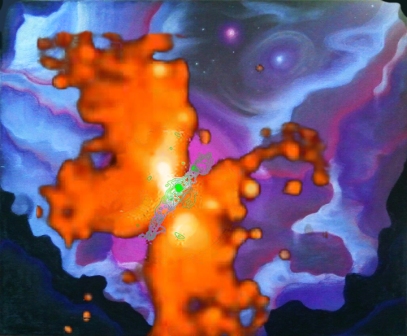An international team of astronomers, led by Dutch scientists, has discovered a region in our Milky Way that contains many nitrogen compounds in the southeast of a butterfly-shaped star formation disk and very little in the north-west. The astronomers suspect that multiple stars-to-be share the same star formation disk, but the precise process is still a puzzle. The article with their findings has been accepted for publication in Astronomy & Astrophysics.

An international team of astronomers studied the star forming region G35.20-0.74N, more than 7000 light years from Earth in the southern sky. The astronomers used the (sub)millimeter telescope ALMA that is based on the Chilean Chajnantor plateau. ALMA can map molecular gas clouds in which stars form.
The researchers saw something special in the disk around a young, heavy star. While large amounts of oxygen-containing and sulfur-containing hydrocarbons were present throughout the disk, the astronomers found only nitrogen-containing molecules in the southeastern part of the disk. In addition, it was 150 degrees warmer on the nitrogen side than on the other side of the disk.
Based on these observations, the scientists suspect that there are multiple stars forming at the same time in one disk and that some stars are hotter or heavier than others. The researchers expect the disk to eventually break into several smaller disks as the stars grow.
A few years ago, there have been observed chemical differences in a star forming region in Orion. First author Veronica Allen (University of Groningen and SRON): “The area in Orion is five times bigger than our area. We have probably been lucky because we expect that such a chemical difference to be short-lived.”
Second author Floris van der Tak (University of Groningen and SRON): “Many of the nitrogen molecules are poisonous cyanides. We do not know much about them because it is dangerous to work with those molecules in laboratories on earth.”
The astronomers are now investigating the star formation cloud in more detail. Allen: “Maybe we can see the disk break into smaller disks in real time.” In addition, the astronomers make models to see how differences in age, mass, temperature or gas density can cause a difference in chemical composition, too.
Veronica Allen
Veronica Allen (USA, 1986) traveled to the United Kingdom to study at the University of Manchester in 2004. However, after her first year, she had to stop because of the high tuition fees for non-EU students. In 2009, she could pursue her studies at EU rate because she then worked in England for five years. In 2013 she obtained her master’s degree in astrophysics at the University of Leeds. She has been a PhD student at the Kapteyn Institute in the University of Groningen and SRON since 2014.
Text: NOVA (www.astronomie.nl)
Astronomen zien raadselachtig stikstofgebied in vlindervormige stervormingsschijf
Een internationaal team van sterrenkundigen, met Nederlanders in de hoofdrol, heeft in het zuidoosten van een vlindervormige stervormingsschijf een gebied ontdekt met veel stikstofhoudende moleculen. In het noordwesten van de schijf is er juist weinig stikstof. De astronomen vermoeden dat meerdere sterren-in-wording dezelfde stervormingsschijf delen, maar wat er precies aan de hand is, is nog een raadsel. Het artikel is geaccepteerd voor publicatie in het vakblad Astronomy & Astrophysics.

Een internationaal team van sterrenkundigen bestudeerde het stervormingsgebied G35.20-0.74N op ruim 7000 lichtjaar van ons vandaan aan de zuidelijke sterrenhemel. De sterrenkundigen gebruikten hiervoor de (sub)millimetertelescoop ALMA op de Chileense Chajnantor-hoogvlakte die de moleculaire gaswolken in kaart kan brengen waarin sterren ontstaan.
De onderzoekers zagen in het stervormingsgebied iets bijzonders in de schijf rond een jonge, zware ster. Terwijl er overal in de schijf grote zuurstofhoudende en zwavelhoudende koolwaterstoffen aanwezig waren, vonden de astronomen alleen in het zuidoostelijke gedeelte van de schijf grote stikstofhoudende moleculen. Daarnaast bleek het aan de stikstofkant ook nog eens 150 graden warmer dan aan de andere kant van de schijf.
Mede op basis van deze waarnemingen vermoeden de wetenschappers dat er zich tegelijkertijd meerdere sterren in die ene schijf aan het vormen zijn. Daarbij zijn sommige sterren heter of zwaarder dan andere. De onderzoekers verwachten dat de schijf uiteindelijk zal opbreken in meerdere kleine schijven als de sterren verder groeien.
Er zijn overigens wel vaker chemische verschillen in één stervormingsgebied gezien, bijvoorbeeld in het sterrenbeeld Orion. Eerste auteur Veronica Allen (Rijksuniversiteit Groningen en SRON): “Maar dat gebied is vijf keer zo groot als het door ons onderzochte gebied. Wij hebben waarschijnlijk geluk gehad, want zo’n chemisch verschil is waarschijnlijk van korte duur.”
Tweede auteur Floris van der Tak (Rijksuniversiteit Groningen en SRON): “Veel van de stikstofmoleculen zijn giftige cyaniden. Daarover weten we verder nog weinig, omdat het hiermee op aarde in laboratoria gevaarlijk werken is.”
De astronomen onderwerpen de stervormingswolk inmiddels aan een gedetailleerder onderzoek. Allen: “Misschien kunnen we de schijf wel live zien opbreken in kleinere schijven.” Daarnaast stellen de sterrenkundigen modellen op om te kijken hoe verschillen in leeftijd, massa, temperatuur of gasdichtheid ook een verschil in chemische samenstelling kunnen veroorzaken.
Veronica Allen Veronica Allen (Verenigde Staten, 1986) reisde in 2004 naar Engeland voor een studie aan de University of Manchester. Ze moest echter na een jaar stoppen vanwege het hoge collegegeld voor niet-EU-studenten. In 2009 kon ze tegen EU-tarief haar studie vervolgen omdat ze vijf jaar in Engeland gewerkt had. Vervolgens behaalde ze in 2013 haar masterdiploma in de astrofysica aan de University of Leeds. Sinds 2014 is ze PhD-student aan het Kapteyn Instituut van de Rijksuniversiteit Groningen en SRON.
Tekst: NOVA (www.astronomie.nl)


